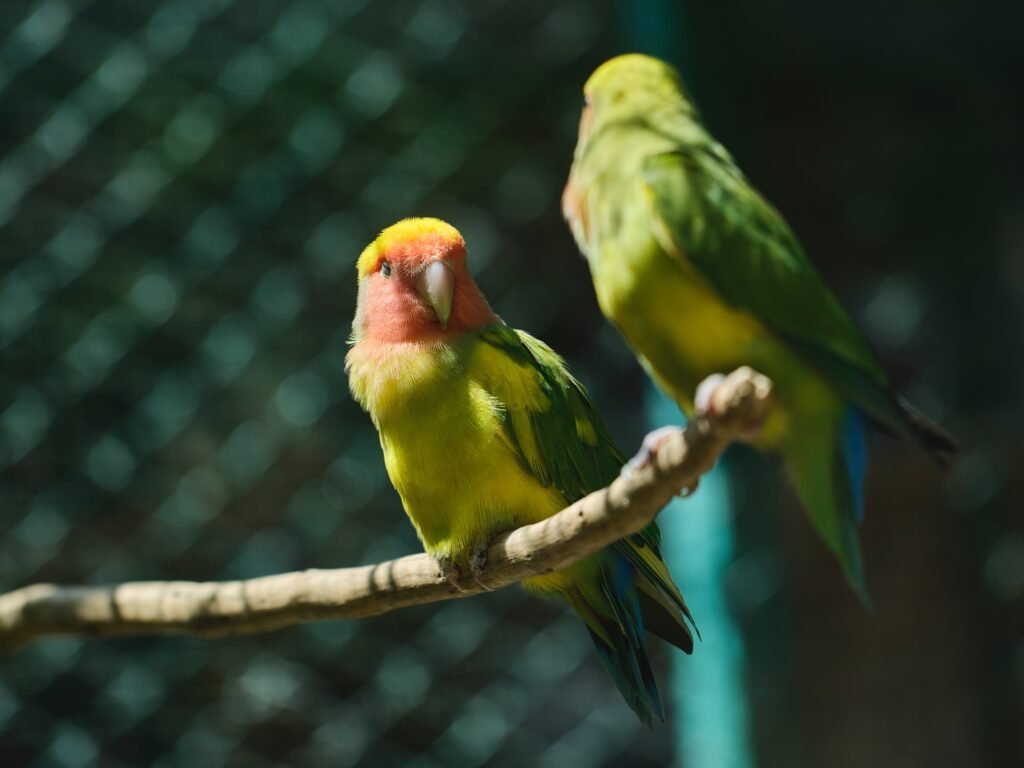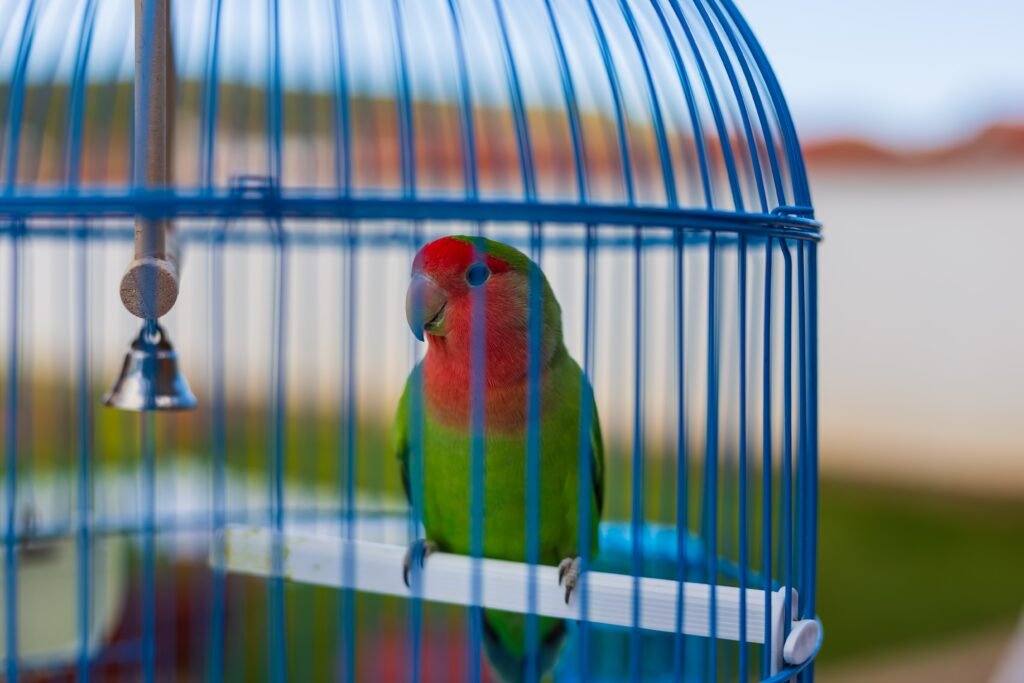One of the most delightful aspects of owning lovebirds is their beautiful and melodious chirping. Lovebirds are known for their enchanting vocalizations, which captivate their owners and serve as a means of communication and expression for these charming avian companions. In this article, we will explore the fascinating world of lovebirds chirping, decoding the meanings behind their various tunes, and understanding the significance of their vocal repertoire.
The Language of Lovebirds
Lovebirds belonging to the genus Agapornis are native to the African continent and are known for their strong pair bonding and affectionate behaviour. Chirping plays a crucial role in their daily lives, serving as a way to communicate with their flock members and express their emotions. Each chirp, tweet, or song carries a unique meaning, allowing lovebirds to effectively convey their intentions, emotions, and needs.
Lovebirds have a diverse vocal repertoire of different types of chirps, each with significance. Understanding the meanings behind these chirps allows you to develop a deeper connection with your lovebirds and better meet their needs.
Deciphering Lovebird Chirps
Understanding the different types of chirps and their meanings can help you develop a deeper connection with your lovebirds. Here are some common chirping patterns and their interpretations:
- Happy Chirping:
Lovebirds are generally cheerful birds, and their happy chirping clearly indicates their contentment and joy. This type of chirping is usually characterized by short, high-pitched sounds, often accompanied by a playful demeanour and vigorous wing flapping. When you hear your lovebirds engaging in happy chirping, it means they are enjoying themselves and are in a positive state of mind. They may play with their toys, explore their environment, or spend quality time with their mate or owner. It’s a sign that they are happy and comfortable in their surroundings.
- Mating Calls:
Lovebirds are renowned for their strong pair bonding and monogamous nature. During the breeding season or when seeking a mate, lovebirds engage in particular chirping patterns known as mating calls. These calls are often more melodious and longer than their regular chirping. Males may use these calls to attract females and communicate their interest, while females respond with softer and subtler chirps, signalling their receptiveness to courtship. Mating calls are important to the lovebirds’ reproductive behaviour and signify their readiness to mate.
- Warning Chirps:
Lovebirds are highly protective of their territories, mates, and nests. When they sense a potential threat or feel agitated, they emit warning chirps to alert others of potential danger. Warning chirps are usually characterized by rapid and repetitive sounds, often accompanied by fluffed feathers, raised crests, and aggressive body language. These chirps serve as a warning signal to other lovebirds and indicate that they should be on high alert. As an owner, paying attention to these warning chirps and ensuring that your lovebirds feel safe and secure in their environment is important.
- Begging Chirps:
Like many other bird species, lovebirds have distinct begging calls when hungry or seeking attention. These chirps are usually softer, have a higher pitch, and are more persistent than their regular chirping. Lovebirds may use begging chirps to communicate their need for food or to gain the attention of their owners. Providing your lovebirds with a balanced and nutritious diet is important to fulfil their dietary requirements and prevent excessive begging behaviour. Make sure to offer a variety of seeds, pellets, fresh fruits, vegetables, and occasional treats to meet their nutritional needs and keep them healthy.
- Contact Calls:
Lovebirds are highly social birds and use contact calls to stay connected with their flock members. These calls help them maintain their bond and ensure the flock’s cohesion. Contact calls are typically short, repetitive chirps that lovebirds use to locate and communicate with each other when they are out of sight. It’s common to hear lovebirds engaging in contact calls when separated or in unfamiliar surroundings, reassuring each other of their presence and maintaining a sense of security. These contact calls are important to their social behaviour and help them establish and strengthen their relationships.
Enhancing Your Lovebird’s Chirping Experience
As a responsible lovebird owner, there are several steps you can take to enhance your lovebird’s chirping experience and promote their overall well-being:
- Provide a stimulating environment: Lovebirds thrive in environments with plenty of mental and physical stimulation. Ensure their cage is spacious and well-equipped with toys, perches, and interactive elements that encourage natural behaviours and playfulness. Introduce safe and suitable toys for lovebirds, such as chewing, puzzles, and foraging, to keep them engaged and mentally stimulated.
- Offer a balanced diet: A nutritious and varied diet is essential for your lovebirds’ health and vocal well-being. To ensure they receive all the necessary nutrients, include a combination of high-quality seeds, pellets, fresh fruits, vegetables, and occasional treats. Consult with an avian veterinarian or a bird nutrition expert to determine the best diet for your lovebirds and make any necessary adjustments based on their needs.
- Spend quality time together: Lovebirds are highly social and crave companionship. Regular interaction with their owners, including gentle handling, talking, and providing opportunities for out-of-cage exploration, can greatly enrich their lives and encourage vocalization. Dedicate daily bonding time with your lovebirds to establish a strong bond and create a positive and trusting relationship.
- Create a peaceful environment: Lovebirds are sensitive to their surroundings, and excessive noise or disturbances can inhibit their natural vocalizations. Ensure their cage is placed in a quiet area, away from loud appliances or frequent foot traffic. Provide a calm and peaceful environment that allows your lovebirds to feel secure and comfortable expressing themselves through chirping.
- Seek professional advice: If you notice any sudden changes or abnormalities in your lovebird’s chirping behaviour, consult an avian veterinarian. They can assess your lovebird’s health and guide any concerns or issues affecting their vocalizations. Regular check-ups and professional advice are essential to ensure the overall well-being of your lovebirds.
Understanding and appreciating your lovebird’s chirping can strengthen the bond between you and these delightful feathered friends. By deciphering their chirping patterns and responding to their needs, you can create a harmonious and joyful environment that allows melodious tunes to flourish. Cherish each chirp, as it is a unique expression of their love and happiness in your care.
Note: This article has been written in Markdown format.
FAQ
Q: Why do lovebirds chirp?
A: Lovebirds chirp to communicate with their flock members and express their emotions. Each chirp has a unique meaning, allowing lovebirds to convey their intentions, emotions, and needs effectively.
Q: What does happy chirping indicate?
A: Happy chirping clearly indicates lovebirds’ contentment and joy. It is characterized by short, high-pitched sounds, often accompanied by a playful demeanour and vigorous wing flapping. Happy chirping means that lovebirds enjoy themselves and are in a positive mind.
Q: What are mating calls?
A: Mating calls are specific chirping patterns that lovebirds use during breeding or when seeking a mate. They are melodious and longer in duration than regular chirping. Males use mating calls to attract females and communicate their interest, while females respond with softer and subtler chirps to signal their receptiveness to courtship.
Q: What are warning chirps?
A: Warning chirps are emitted by lovebirds when they sense a potential threat or feel agitated. These chirps are rapid and repetitive, often accompanied by fluffed feathers, raised crests, and aggressive body language. Warning chirps signal other lovebirds to be on high alert and indicate the need for increased vigilance and safety measures.
.


